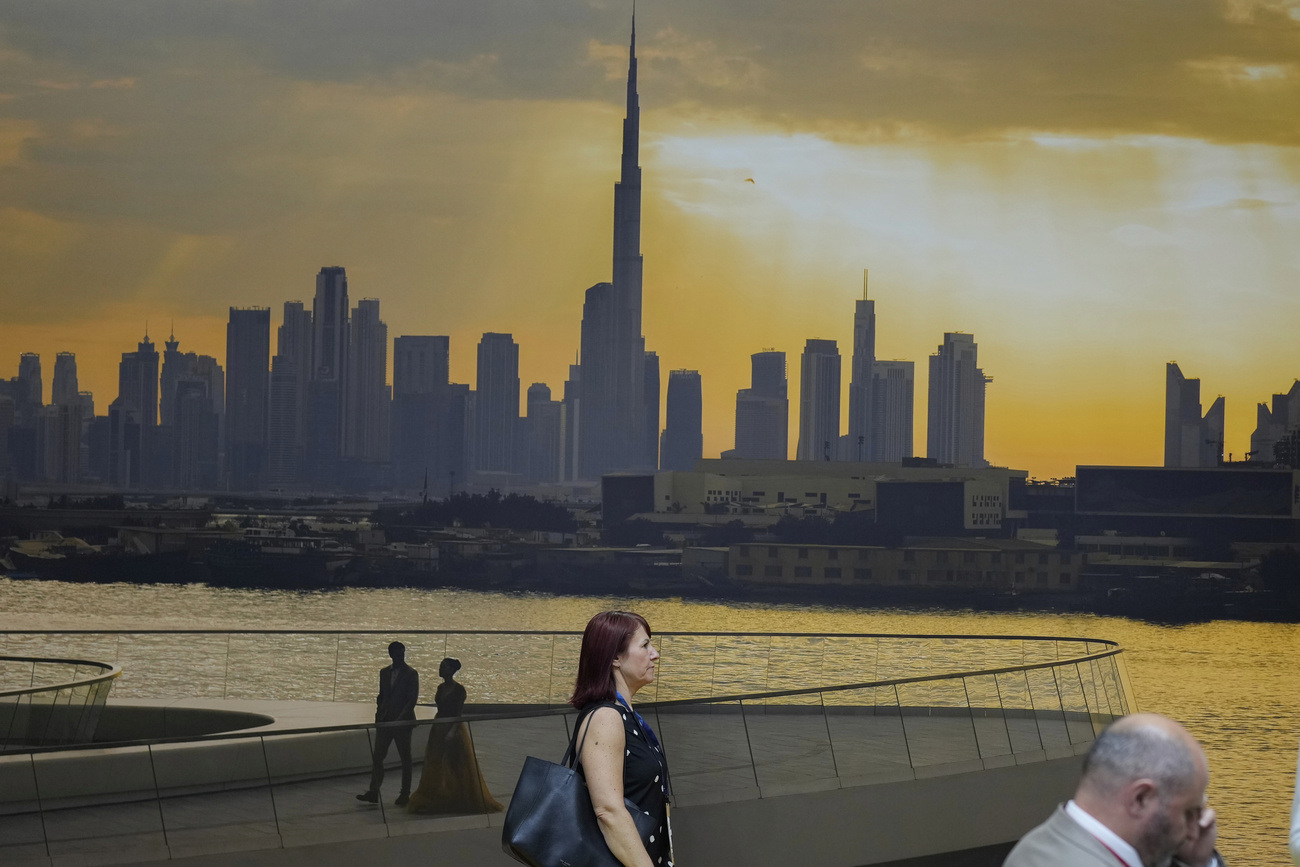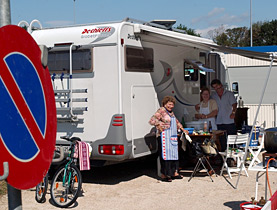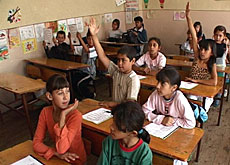Keeping gypsies and locals on a straight road

Gypsy caravans are a familiar sight each summer in Switzerland, but their arrival often leads to upset among the local population.
Cultural mediator Nadia Bizzini, who works in the Italian-speaking border canton of Ticino, tells swissinfo.ch that relations between the two communities are still beset by prejudice and misunderstandings.
In medieval times, travellers were said to be the descendants of Cain. Nowadays they make up the largest minority in Europe, at around 15 million people, and are divided into different ethnic groups, such as the Jenisch, Roma, Sinti and Manush.
In late June, the Federal Commission against Racism condemned an attack on travellers near Bellinzona in which shots were fired. It said in a statement that the incident was only “the tip of the iceberg”.
swissinfo.ch: What does your job involve?
Nadia Bizzini: I make contact with the travellers to understand their needs and to raise awareness of their duties. I also try to set up a dialogue with the local population, to dispel prejudices.
Over the past four years, two main aspects have emerged: the locals’ fear of crime and the travellers’ sometimes disrespectful behaviour when on sites, especially over hygiene.
swissinfo.ch: People speak of gypsies, Roma and Jenisch. To which community do the Swiss travellers belong?
N.B.: What we normally call gypsies are the peoples originating from northern India and divided into Roma, Sinti, Manush and Jenisch.
The majority of Swiss travellers are Jenisch, whereas the foreigners are mostly first-generation Roma. These are peoples who emigrated within Europe at the beginning of the 20th century and who have French, Italian or Spanish nationality, mostly now in the fourth generation. They have never stopped travelling and have kept their traditions.
On the other hand, the second-generation Roma fled their countries during or after the Balkan war and have often settled on illegal sites near large cities, such as Milan and Turin. They have lost all links to their culture and – despite having the same ethnic origins – no longer have anything in common with first-generation Roma. They don’t come to Switzerland; sometimes they come over the border to beg with their children or to steal. They are desperate, jobless or employed in the lowest-wage manual labour.
swissinfo.ch: How are travellers’ stays in Switzerland managed?
N.B.: Traveller groups are easily recognisable: they come in caravans with big satellite dishes but without the bicycles that tourists might have. As soon as they arrive at the border, their presence is signalled to the cantonal authorities. The travellers often warn me directly or call the police. The site is then opened and they settle in. I go over to welcome them and to explain the basic rules for a good neighbourly atmosphere. Police carry out routine controls, taking licence plate numbers, checking passports and registering them.
There are around 100 travellers that come to Ticino every season. They belong to two big family clans who know each other but don’t always get along. Most of them have a house in their country of residency, but they seldom stay there because they find it hard to be enclosed within four walls. They find it suffocating.
swissinfo.ch: What does it mean to live in a transit site?
N.B.: There are no official gypsy sites in Ticino, only emergency sites, which means flat zones which can be used for a limited time. The only equipped site is at Galbisio, near Bellinzona. I say equipped, but it doesn’t have any electricity or adequate hygiene facilities and running water is provided by a fountain.
It’s not easy for the travellers to live in these conditions. This lack of facilities makes my work and that of the authorities more difficult as well. Sometimes there are more than 30 caravans on these sites, from different clans, and living together is not always easy.
swissinfo.ch: What are the travellers’ priorities?
N.B.: Undoubtedly to have better-equipped official transit sites. The issue is not whether we should accept them, but how to manage their presence. The travellers themselves would like “protected zones” fitted with barriers and with regular checks of those going in and out, rather like at camping sites. A deposit system, to punish any abuses, could also be envisaged. The number of caravans should also be limited to a maximum of 15-20, from the same clan, to allow for a form of social control within the group.
From what I’ve been told, travellers still suffer from racism in Ticino and Italy. They feel under pressure, judged, stigmatised. These conditions make my work impossible – it’s an emergency intervention, at the last minute. Until there are proper sites, we can’t really draw up a gypsy management strategy. And I continue to work with emotions rather than using more efficient instruments.
swissinfo.ch: What other problems do you face in your mediation work?
N.B.: These nomadic peoples have a very strong temperament and a way of communicating which we are not used to. Even when asking for directions, they do it very directly: “Oy you, tell me where this place is”. This is cultural behaviour which has been transmitted down through the generations, but to which I have not yet become fully accustomed.
When I try to tell them that they shouldn’t have thrown their rubbish out into the streets, I have to use an unfamiliar communication register. It’s no use speaking in a normal and calm tone. I have to raise my voice, turn my back and refuse to argue.
I’ve never felt in danger during these four years in the job. I’ve had good times with them. They make me feel part of the family, even if I am always a “gadjé”, not a traveller. The other day, a woman invited me to eat with them and I refused and she said: “don’t behave towards me as if you were a foreigner”. They have a strong sense of solidarity, cohesion, respect and honour. For them it’s easier to deal with discrimination that an affront from a member of what they consider a big family.
Stefania Summermatter, swissinfo.ch (Translated from Italian by Isobel Leybold-Johnson)
Roma, Sinti, Kale, Lovara, Machvaya are just some of the hundreds of nomadic groups using the Romani language, who originally came from northwestern India between the 10th and 14th centuries. They moved in waves first towards Asia Minor and then towards North Africa and Greece, before fanning out across Europe.
Although grouped together as travellers (or more pejoratively as gypsies), these nomadic peoples are in reality very diverse, in terms of ethnic background but also in terms of language, culture and religion of the country in which they reside.
They have been persecuted and discriminated against for hundreds of years and now live on the margins of society – not through choice. Prejudice against them is still rife.
They make up the largest ethnic minority in Europe, but it is hard to gain a clear overview. Some estimates have their numbers at 15-20 million. Most live in central western Europe, with around two million in Romania.
The community is made up of around 30,000 members in Switzerland, with most not having a nomadic lifestyle.
In Switzerland, as in the rest of Europe, travellers were considered not able to follow the values and laws of the land.
In 1906 the Swiss government decided to close the borders to travellers.
In 1926 youth organisation Pro Juventute started the Children of the Road project, supported by local and national authorities. Children were removed from their parents and placed in children’s homes or with foster parents to take them away from a travelling lifestyle. Around 600 children were affected between 1926-1972.
Travellers, whether living a nomadic lifestyle of not, only managed to gain legal protection accorded to minorities in the 1970s. But this does not totally protect them against discrimination.
(Source: Nadia Bizzini)

In compliance with the JTI standards
More: SWI swissinfo.ch certified by the Journalism Trust Initiative

















You can find an overview of ongoing debates with our journalists here . Please join us!
If you want to start a conversation about a topic raised in this article or want to report factual errors, email us at english@swissinfo.ch.